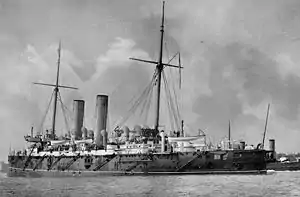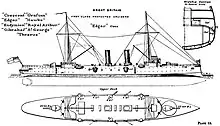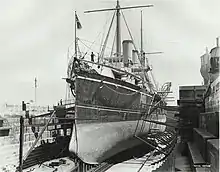 HMS Gibraltar | |
| Class overview | |
|---|---|
| Name | Edgar class |
| Operators | |
| Preceded by | Blake class |
| Succeeded by | Powerful class |
| Built | 1889–1894 |
| In commission | 1893-1921 |
| Completed | 9 |
| Lost | 1 |
| Scrapped | 8 |
| General characteristics | |
| Type | First class protected cruiser |
| Displacement | 7,700 tons |
| Length | 387 ft 6 in (118.11 m) |
| Beam | 60 ft (18.3 m) |
| Draught | 24 ft (7.3 m) |
| Propulsion | 2 shafts, 12,000hp |
| Speed | 20 knots (37 km/h) forced draught |
| Range | 10,000 nautical miles (19,000 km) at 10 knots (19 km/h) |
| Complement | 544 |
| Armament | |
The Edgar class were nine first-class protected cruisers built for the Royal Navy under the Naval Defence Act of 1889. The class gave long service and all of the ships participated in the First World War. One, HMS Hawke, was lost during the war, with the other eight being scrapped in the 1920s.
Design
Nine new first-class cruisers were required by the Naval Defence Act. Although the Blake-class cruisers were impressive ships and powerful, they were too large and expensive to simply repeat en masse.
The new ships were envisioned as reduced version of Blake and Blenheim, retaining the same main armament of two 9.2-inch BL guns ten 6-inch QF guns. The 9.2-inch pieces were mounted singly on the centreline at either end of the upper deck, on turntable mountings provided with heavily-armoured open-backed gunshields which resembled turrets. The 6-inch battery was divided between two decks on each beam, with six upper deck guns (three on each beam) and four on the main deck, two to a beam. The main deck guns were in casemates, while the six upper deck guns were protected only by shields. For close-range defence against torpedo boats there were 12 QF 6-pounder Hotchkiss guns and four QF 3-pounder Hotchkiss guns. Armament was completed with four 18-inch torpedo tubes.
Displacement was reduced by 1,800 tons from Blake, length between perpendiculars by 15 feet. Propulsion came from steam expansion engines,[2] driving two shafts. With funnels as tall as the Blake class, the Edgars appeared stockier than the preceding ships. Despite this, slimming their beam by 5 feet, slightly reducing draught and providing highly reliable 12,000 ihp machinery (compared with the previous troublesome 13,000 ihp installation) meant the new ships would practically match their two larger predecessors' steaming performance.
The Edgar class' main armour protection was an internal protective deck, consisting of 5 in (130 mm) thick steel armour on the outboard slopes, which connected with the hull plating just below waterline level and rose up the further it extended into the ship, with 3 in (76 mm) on the flat of the deck over the magazines and machinery spaces. The gun casemates were 6 in (150 mm) thick, with 3 in (76 mm) shields for the 9.2-inch guns. The conning tower had 10 in (250 mm) armour. Four of the Edgar class were fitted with anti-torpedo bulge during refit in 1914.
Crescent and Royal Arthur were intended to operate as flagships for cruiser squadrons on foreign stations. They were built to a slightly modified design and are sometimes considered a separate class. In order to accommodate the additional flag officers and staff in the forward part of the ship, they had a forecastle one deck higher than their other sisters'. This additional weight forwards was balanced by the deletion of the forward 9.2-inch gun and its very heavy armoured gunshield, with sufficient weight allowance remaining afterwards for two additional 6-inch guns to be placed, sided, atop the forecastle in light open-backed shields.
Building programme
The following table gives the build details and purchase cost of the members of the Edgar class. Standard British practice at that time was for these costs to exclude armament and stores.


.jpg.webp)
| Ship | Builder | Maker of Engines |
Construction | Cost according to Brassey's Naval Annual | ||||
|---|---|---|---|---|---|---|---|---|
| Laid down | Launched | Completed | BNA 1895[3] | BNA 1905[4] | BNA 1906[5] | |||
| Edgar | Devonport Dockyard | Elder | 3 Jun 1889 | 24 Nov 1890 | 2 Mar 1893 | £401,083 | £428,081 | £410,980 |
| Hawke | Chatham Dockyard | Elder | 16 Jun 1889 | 11 Mar 1891 | 16 May 1893 | £365,491 | £413,101 | £400,702 |
| Endymion | C & W Earle, Hull | Earle | 22 Nov 1889 | 22 July 1891 | 26 May 1894 | £350,459 | £397,973 | £375,250 |
| Royal Arthur ex-Centaur |
Portsmouth Dockyard | Maudslay | 20 Jan 1890 | 26 Feb 1891 | 2 Mar 1893 | £402,414 | £427,620 | £412,033 |
| Gibraltar | Robert Napier & Sons, Govan | Napier | 2 Dec 1889 | 27 Apr 1892 | 1 Nov 1894 | £347,634 | £377,741 | £373,236 |
| Grafton | Thames Ironworks Leamouth | Humphrys | 1 Jan 1890 | 30 Jan 1892 | 18 Oct 1894 | £351,851 | £381,958 | £372,890 |
| St George | C & W Earle, Hull | Maudslay | 23 Apr 1890 | 23 Jun 1892 | 25 Oct 1894 | £377,204 | £407,540 | £388,755 |
| Theseus | Thames Ironworks Leamouth | Maudslay | 16 Jul 1890 | 8 Sep 1892 | 14 Jan 1894 | £347,577 | £377,913 | £370,359 |
| Crescent | Portsmouth Dockyard | Penn | 13 Oct 1890 | 30 Mar 1892 | 22 Feb 1894 | £383,068 | £411,108 | £392,453 |
Notes
- ↑ Gardiner, Robert, ed. (1979). Conway's All the World's Fighting Ships 1860–1905. Greenwich: Conway Maritime Press. pp. 66. ISBN 0-8317-0302-4 – via The Internet Archive.
- ↑ "H.M.S. Hawke" (PDF). The Engineer. 18 March 1892. p. 229.
- ↑ Brassey's The Naval Annual 1895, p201-217
- ↑ Brassey's The Naval Annual 1905, p242-249
- ↑ Brassey's The Naval Annual 1906, p216-223
References
- Colledge, J. J.; Warlow, Ben (2006) [1969]. Ships of the Royal Navy: The Complete Record of all Fighting Ships of the Royal Navy (Rev. ed.). London: Chatham Publishing. ISBN 978-1-86176-281-8.
- Brassey, Lord (ed) Brassey's The Naval Annual 1888-89
- Brassey, T.A. (ed) Brassey's The Naval Annual 1890
- Brassey, T.A. (ed) Brassey's The Naval Annual 1891
- Brassey, T.A. (ed) Brassey's The Naval Annual 1892
- Brassey, T.A. (ed) Brassey's The Naval Annual 1893
- Brassey, T.A. (ed) Brassey's The Naval Annual 1894
- Brassey, T.A. (ed) Brassey's The Naval Annual 1895
- Brassey, T.A. (ed) Brassey's The Naval Annual 1896
- Brassey, T.A. (ed) Brassey's The Naval Annual 1899
- Brassey, T.A. (ed) Brassey's The Naval Annual 1902
- Brassey, T.A. (ed) Brassey's The Naval Annual 1903
- Brassey, T.A. (ed) Brassey's The Naval Annual 1904
- Brassey, T.A. (ed) Brassey's The Naval Annual 1905
- Leyland, J. and Brassey, T.A. (ed) The Naval Annual 1906
- Gardiner, Robert, ed. (1979). Conway's All the World's Fighting Ships 1860–1905. Greenwich: Conway Maritime Press. p. 440. ISBN 0-8317-0302-4.